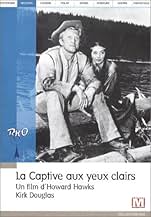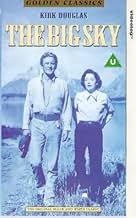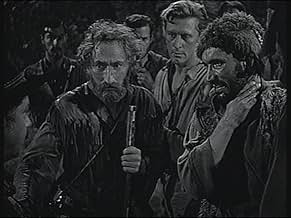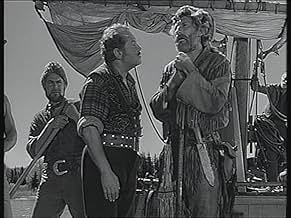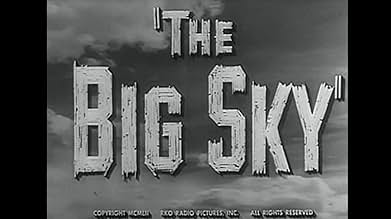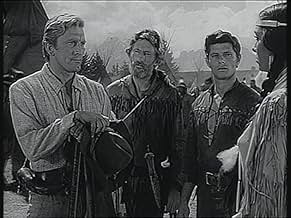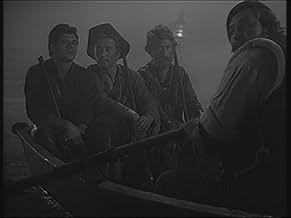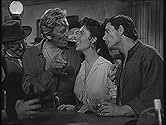El éxito del viaje se centra en mantener con vida a la joven india y a ellos mismos para completar el comercio con los Blackfeet.El éxito del viaje se centra en mantener con vida a la joven india y a ellos mismos para completar el comercio con los Blackfeet.El éxito del viaje se centra en mantener con vida a la joven india y a ellos mismos para completar el comercio con los Blackfeet.
- Dirección
- Guionistas
- Elenco
- Nominado a 2 premios Óscar
- 3 nominaciones en total
- Blackfoot Dancer
- (sin créditos)
- Horse Trader
- (sin créditos)
- Tavern Patron
- (sin créditos)
- Tavern Proprietor
- (sin créditos)
- Tavern Patron
- (sin créditos)
- Jailer
- (sin créditos)
- Blackfoot Subchief
- (sin créditos)
- Pascal
- (sin créditos)
Opiniones destacadas
Well worth your time and any children should be shown it as well because they'll remember it throughout their lives. I certainly have!
But in my opinion The Big Sky stands on the level of Howard Hawk's best work remarkable for its visual beauty (though filming it in colour would definitely improve it), fine performances (Kirk Douglas is magnificent here and it's hard to imagine other actor playing this role), wonderful music from Dimitri Tiomkin and interesting story of, basically, friendship, that even might be called love, between the two main characters of Jim Deakins (Kirk Douglas) and Dewey Martin (Boone Caudill) but friendship on a background of a perilous and adventurous journey up the Missouri river to the Indian territory where no white man ever set his foot before, with a group of peculiar French adventurers and an Indian princess Teal Eye (Elizabeth Threatt) who steals their hearts and threatens their friendship.
A must see classic. 9/10
1832 and Jim Deakins (Douglas) & Boone Caudill (Martin) meet by chance out in the wilderness. Quickly bonding they travel to St Louis together to seek out Boone's Uncle Zeb (Hunnicutt). After finding him via a bar room brawl, the two men agree to join Zeb in a venture up the Missouri river to trade fur with the unpredictable Blackfoot Indians; their insurance against attack by the Blackfoot coming courtesy of Teal Eye (Threatt), a beautiful Blackfoot princess kidnapped years previously and now being returned home. Along the way the party have to battle nature, the Indian factions and also the Missouri Company out to topple their enterprise for fear of losing their monopoly on trade. Perhaps worse still is that the new found friendship between Boone & Jim will be tested by their mutual attraction to Teal Eye?
Given the credentials that come with The Big Sky, it's a little surprising that it's not more well known. Hawks, Douglas and Tiomkin speak for themselves, while Guthrie wrote the script for Shane and Nichols wrote the screenplay for John Ford's 1939 pulse raiser, Stagecoach. Add in that Hunnicutt and Harlan were Academy Award nominated for Best Support Actor and Cinematography respectively, well you have a fine bunch of professionals involved with this movie. So why so ignored or forgotten? The starting point should be with Hawks himself, who openly had issues with the finished product. Originally the film was a huge 140 minutes long and was doing decent business at the box office. But the studio execs had it cut down to 122 minutes so as to fit one more screening in during the day. The film promptly flopped and was left for dead by director and studio. Hawks was also never fully behind Douglas in the role of Deakins, he had wanted Gary Cooper or John Wayne. It seems in the end that Hawks just walked away after release and lost faith in promoting it. Western fans were grateful that the experience didn't make him turn his back on the genre, tho, for he delivered Rio Bravo 7 years later.
Having not seen the full uncut version of the film, I personally have to say that the 122 minute version viewed was pretty uneven and lacking a certain narrative spark to make it fully work. It's even episodic for the most part. What isn't in doubt is that visually it's one of Hawks' most rewarding pictures, with Harlan's photography sumptuous and period perfecto. Douglas is spirited and plays the black humour within quite nicely, while Martin is good foil for Douglas' beaming machismo, even if he's just a little too animated at times. Threatt doesn't have to do anything other than smile and look pretty, while Hank Worden shows up to neatly play a buffoon Indian called Poordevil! Undoubtedly the star of the show is Hunnicutt (who also narrates), tucking into a boozy, grizzled, teller of tall tales character, Hunnicutt lifts the film on the frequent occasions it threatens to sag beyond repair.
With the visuals and enjoyable Hawksian take on "man love" the film is worth the time of any Western fan. While the efforts to resist racism are honourable and neatly played. But in the end Hawks' frustration is justified, for it feels like a patched together adventure piece. And certainly not one that makes you think it's directed by the man who made Red River. I wouldn't hesitate to watch the full 140 minute cut of the film, but until then it will be some time before I can see myself watching this version again. 6/10
Footnote: Some Region 2 DVD's exist of the full cut, where the cut scenes have been spliced back in from a 16mm print. I'm led to believe that the quality is far from great. For British readers, the 122 minute cut shows up once in a blue moon on TV, where the BBC have the rights so at least it is advertisement free. As yet there is still no Region 1 release for the film.
"The Big Sky" was filmed on location, and this alone makes the film worth watching, for the splenor of the Snake River and Grand Tetons, where the film was actually shot, is breathtaking.
But "The Big Sky" has other virtues which raise it far above the average "scenic". First, is the multi-layered plot. Besides the story of an enterprise, "The Big Sky" is about how men, in a time long past, interacted, when their differences were subordinated to a higher purpose. Second, is director Howard Hawks, whose trademark "naturalistic dialogue" technique is put to wonderful use here. Hawks works on complex relationships - male and female, "Frenchie" and Anglo backwoodsmen, Native Americans and whites - like a conductor a symphony. Third, and perhaps most touching, is the tale of male bonding not only among the group of men, but one-on-one between Jim Deakins, played by Kirk Douglas, and Boone, his young sidekick, played by Hawks protegé Dewey Martin. There's a nice, touching story toward the end.
This is a shamefully underrated film. Superb cinematography (Oscar nominated), rich plot, flawless casting (Arthur Hunnicutt nominated for Best Supporting Oscar), masterful direction, make "The Big Sky" a true classic.
¿Sabías que…?
- TriviaWhile shooting Río Rojo (1948), there was a scene that director Howard Hawks unsuccessfully urged John Wayne to do. It involved his getting a finger mangled between a saddle horn and a rope, resulting in Walter Brennan's amputating it. Hawks reportedly told Wayne, "If you're not good enough, we won't do it", but Wayne wouldn't do it. According to Hawks biographer Todd McCarthy, Hawks did get Kirk Douglas to do that scene in this film, and it came off so funny that Wayne later declared to Hawks, "If you tell me a funeral is funny, I'll do a funeral."
- ErroresJim expresses amazement at the size of St. Louis. However, he had just come from Louisville, which in 1832 was about twice the size of St. Louis, so it should not have been a source of such astonishment.
- Citas
Zeb Calloway: Blackfeet... proud injuns. They ain't gonna let no white man spile their country. The only thing they'a feared of is a white man's sickness.
Boone Cardell: What's that?
Zeb Calloway: Grabs. White men don't see nothing pretty unless they want to grab it. The more they grab, the more they want to grab. It's like a fever and they can't get cured. The only thing for them to do is to keep on grabbin' until everything belongs to white men and then start grabbin' from each other. I reckon injuns got no reason to love nothing white.
- Créditos curiososInstead of the traditional RKO morse code sound, the film's opening theme music is played over the RKO radio tower image. Later, a title card is displayed explaining the premise of the story.
- ConexionesReferenced in Pour la peau d'un flic (1981)
Selecciones populares
Detalles
- Fecha de lanzamiento
- País de origen
- Idiomas
- También se conoce como
- Horizontes salvajes
- Locaciones de filmación
- Productoras
- Ver más créditos de la compañía en IMDbPro
Taquilla
- Presupuesto
- USD 2,000,000 (estimado)
- Tiempo de ejecución
- 2h 20min(140 min)
- Color
- Relación de aspecto
- 1.37 : 1


